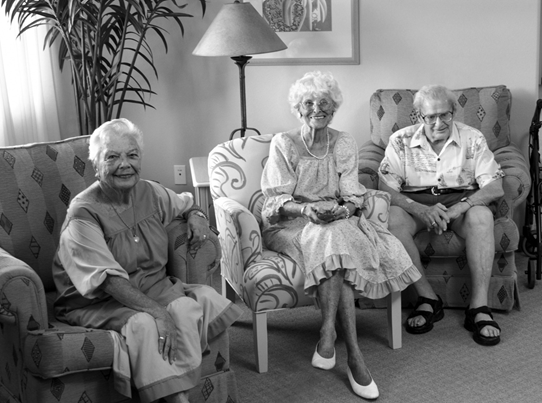
What are my Long Term care options?
You may have other long-term care options (besides nursing home care) available to you. Talk to your family, your doctor or other health care provider, a person-centered counselor, or a social worker for help deciding what kind of long-term care you need.
If you’re in a hospital, nursing home, or working with a home health agency, you can get support to help you understand your options or help you arrange care. Talk to:
- A discharge planner.
- A social worker.
- An organization in a “No Wrong Door System,” like an Aging and Disability Resource Center (ADRC), Area Agency on Aging (AAA), or Center for Independent Living (CIL). See page.
For general information on long-term care, visit longtermcare.acl.gov. See page for a list of resources to help you get more information. American Indians and Alaska Natives can contact their local Indian health care providers for more information.
You can consider both community and residential long‑term care options.
Community-based services
There are many long-term care options that may be available in your community, including:
Home‑ and community‑based services: A variety of home- and community-based services may be available to help with your personal care and activities.
Medicaid may cover some services, including:
- Home care (like cooking, cleaning, or help with other daily activities)
- Home health services (like physical therapy or skilled nursing care)
- Transportation to medical care
- Personal care
- Respite care
- Hospice
- Case management
Medicaid programs vary from state to state. Medicaid may offer more services in your state. To get the phone number for your State Medical Assistance (Medicaid) Office, visit Medicare.gov/contacts or call 1-800-MEDICARE (1-800-633-4227). TTY users can call 1-877-486-2048.
These types of services may also be available through other programs, like the Area Agency on Aging, Medicare, or hospice programs. For more information about Medicare’s coverage of hospice and home health services, visit Medicare.gov.
Community sources, like volunteer groups that help with things like shopping or transportation, which may be free or low cost (or may ask for a voluntary donation), are another option. Here are some examples of the services and programs that may be available in your community:
- Adult day services
- Adult day health care (which offers nursing and therapy)
- Care coordination and case management (including transition services to leave a nursing home)
- Home care (like cooking, cleaning, or help with other daily activities)
- Meal programs
- Senior centers
- Friendly visitor programs
- Help with shopping and transportation
- Help with legal questions, bill pay, and other financial matters
Programs of All inclusive Care for the Elderly (PACE): PACE is a type of Medicare and Medicaid Program offered in many states. PACE helps people who would otherwise need nursing home-level of care to stay in their community.
To qualify for PACE, you must meet these conditions:
- You’re 55 or older.
- You live in the service area of a PACE organization.
- Your state certifies that you need a nursing home-level of care.
- At the time you join, you’re able to live safely in the community with the help of PACE services.
Residential care options
There are many long-term care options that may be available in a residential setting, including:
Accessory dwelling units (ADUs): An ADU (sometimes called an “in-law apartment,” “accessory apartment,” “or a “second unit”) is a second living space within a home or on a lot. It has a separate living and sleeping area, a place to cook, and a bathroom. If you or a loved one owns a single-family home, adding an ADU to an existing home may help you keep your independence.
Existing space, like an upper floor, basement, attic, or over a garage, may be turned into an ADU. Family members may be interested in living in an ADU in your home, or you may want to move into an ADU at a family member’s home.
Check with your local zoning office to be sure ADUs are allowed in your area, and find out if there are any special rules. The cost of an ADU can vary widely, depending on many factors, like the size of the project.
Continuing Care Retirement Communities (CCRCs): Some retirement communities offer different kinds of housing and levels of care. In the same community, there may be individual homes or apartments (for residents who still live on their own), an assisted living facility (for people who need help with daily care), and a nursing home (for people who require higher levels of care).
Residents can move from one level to another based on their individual needs, but usually stay within the CCRC. If you’re considering a CCRC, be sure to check the quality information and inspection report (posted in the facility) of its nursing home.
Group living arrangements: Residential care communities (sometimes called “adult foster/family homes” or “personal care homes”) and assisted living communities are types of group living arrangements. In some states, residential care and assisted living communities mean the same thing. Both can help with some of the activities of daily living, like bathing, dressing, using the bathroom, and meals. Whether they offer nursing services or help with medications varies by state.
In most cases, residents of these communities pay a regular monthly rent and additional fees depending on the type of personal care services they get.
Subsidized senior housing: There are state and federal programs that help pay for housing for some seniors with low to moderate incomes. Some of these housing programs also offer help with meals and other activities, like housekeeping, shopping, and doing the laundry. Residents usually live in their own apartments within an apartment building. Rent payments are usually based on a percentage of a person’s income. For more information, visit hud.gov/topics/information_for_senior_citizens.

